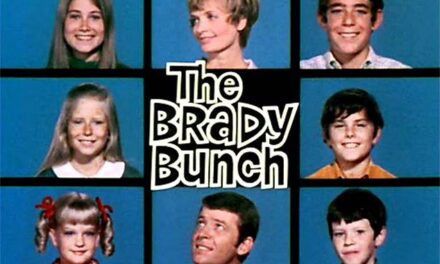Nandor the Relentless (Kayvan Novak): ‘It might have been a he. They [his wives] weren’t all women.’
Guillermo de la Cruz (Harvey Guillén): ‘You could do that back then?’
Nandor the Relentless: ‘Of course. Some of my wives were girl wives, some of them were guy wives. It’s not that different.’ (4.2)
The above exchange from What We Do in the Shadows (FX, 2019-2024, hereafter WWDITS) is a representative example of the engagement with queer identities within the series. For those unfamiliar with it, the series is ostensibly a documentary which is being shot by a (mostly) unseen crew who follow the lives of three vampires in Staten Island, Nandor, the British Laszlo (Matt Berry) and his wife (and sire) the ‘Antipaxon’ Nadja (Natasia Demetriou) who are all housemates. Living with them is the energy vampire Colin Robinson (Mark Proksch) and Nandor’s familiar (and, latterly, the vampires’ bodyguard) Guillermo. While the series is supposedly about the vampires’ attempts to conceal themselves from humans by attempting to fit in (whence much of the comedy and sociocultural critique comes), what it also accomplishes is effectively humanising the ‘monsters’ by showing them as a group of complex, flawed friends and lovers. It is this point that I shall explore within this blog. Specifically, I shall focus upon Nandor and the significance of the quote above in which, for the first time in the series, he tells Guillermo (and the audience) that his harem were not exclusively women.
Within the series this is not unusual. All of the main characters are explicitly queer; the vampires are all bisexual and Guillermo is gay. But the queer identities seem to pre-date the characters’ becoming vampires,[1] which is particularly relevant in the case of Nandor. He is from thirteenth-century ‘Al Qolnidar,’ a fictitious country which Nandor says in 1.8 is located in what is now Southern Iran. The name of the country seems to be a play on the Persian terms for ‘poor’ and for ‘brave’ which are very close in pronunciation (‘niDar’ and ‘naadaar’ respectively, the latter possibly related to the Greek ‘andros’ for ‘man’ with [gendered] connotations of bravery). These terms are used in Sufi poetry – the name ‘Nandor’ is etymologically similar though ‘nan’ means ‘bread’ in contemporary Persian. ‘Poor’ is the closest in contemporary Persian – ‘not’ and ‘at’ (‘nh’ and ‘dr’) may be the more literal translation ‘Alqol’ is likely ‘alcohol,’ something strongly associated with ancient Greek portrayals of Persians (i.e., as drunk, luxury-loving and indolent, all of which they tie negatively to ideas of ‘effeminacy’ and poor military performance, cf Foxhall, 1998). This helps create ambiguity – Nandor does note that his army were drunk whilst invading but he was very successful, plus the pun of being ‘drunk’ meaning both being inebriated as well as having one’s blood drunk by a vampire (the pun appears in 1.1). Nandor himself is an ambiguous character as a somewhat repentant military leader who now prefers to negotiate rather than engage in violence as the first option. Yet he is also a vampire, whose life depends on killing humans, several of whom he has fallen in love with over the years (including an implied, reciprocated love with Guillermo). Nandor’s capacity for love is also relevant to the linguistic analysis of poetry as it is a key representation of Persian and Ottoman cultures, particularly in the context of Sufi mysticism, homosexual desire and its analogies between divine love with love between men (Wafer, 1997; Murray, 1997).
In the late thirteenth century, the Ottoman Empire also developed; it and the Persian Empire were neighbouring polities which occasionally were in conflict. Regardless, Nandor states at various times that he was an Ottoman soldier and his travels brought him westward as an invader, presumably as the Ottoman Empire expanded. It is unclear at what point in his military and political career he became a vampire, but the Ottomans apparently appointed him as the leader of Al Qolnidar so this implies that Nandor was likely an Ottoman client king in the early Empire.[2] We do know that, as leader, he had a harem which totalled 37 at least some of whom he had a genuine emotional connection with (4.2) and at least some of whom he procreated with as he does have living descendants (1.10) so he was human at least part of this time. Hanley (2016) notes the complexity of the concept of citizenship and nationality in later Ottoman law, stating that ‘Ottoman law attributed nationality by territory of birth only rarely’ (2016: 279) and that there was intermarriage between Ottomans and Persians commonly enough to require citizenship laws for them; Murray (2007: 102) similarly states that the Ottoman Empire ‘…also provided significant opportunities to talented individuals regardless of national or religious background.’ Thus Nandor’s seemingly dual identity as a Persian-speaking Ottoman from what is now Southern Iran can be understood in this way in addition to expressing that Nandor is played by a British-Persian actor.
Edgerton (2020) argues that the reasons why a portrayal of the past occurs at a given point is more important than its historical accuracy. While I absolutely agree with him, in this instance the factual accuracy (or lack thereof) is at least part of the point. All of this history, diegetic and extradiegetic, is relevant specifically with regard to Nandor as an explicitly queer Persian man who lived and worked under the Ottoman Empire. There is a strong tradition of queer men in Ottoman and Persian history, particularly during the period in which Nandor was born, lived as a human and operated as an Ottoman general.[3] Delice (2010) argues that history, including Ottoman history, is coloured by heteronormativity whilst Arvas (2014) argues the same about Ottoman literature. He begins his chapter by stating
Early modern Ottoman poetry is predominantly about love and for the most part, both the subject and the object of this love are men. Same-sex male erotic desire…is central to various genres… a wide array of…male objects of love calls attention to how same-sex desire is a complex phenomenon in early modern representations. Yet, in the nineteenth century, Westernization and the change in social dynamics at home transformed the “queer” paradigm of this literary lineage, and heteronormativity has since then colored the literary imagination, transforming the beloved into the pervert (2014: 145).
Arvas (2014) is one of the many scholars to point out that same-sex desire has existed in cultures (and humans) from long before Western influence. Crucially, he also notes that Westernisation played a role in the shift to heteronormativity. This tension broadly matches what Makdisi (2002) terms ‘Ottoman Orientalism’ in which there is simultaneous acceptance and rejection of Western views of the Ottoman Empire in the nineteenth century. This tension can perhaps also be seen in that 4.2 is the first time Nandor tells Guillermo (and the audience) that his harem contained men and women (third-gender people are not referenced). In previous episodes Nandor had referred to his wives as all being women, though in 2.9 it is stated that Laszlo and Nandor were occasional sexual partners (which was on-going as of 5.8) and their (ardently supportive) neighbour Sean (Anthony Atamanuik) believes that Nandor and Guillermo are partners by 3.5. The diegetic (and possibly extradiegetic) reasons for the change in how Nandor’s harem is described are unclear but by series four he is not only explicitly queer as a vampire but was also queer when he was human, showing the same point that Arvas (2014), Delice (2010) Murray (2007; 1997) and Wafer (1997) have all made. All of the vampires are viewed as ‘unholy’ (explicitly stated in the series) and if any of them identified as Muslim or Anglican or Greek Orthodox while humans they do not consider themselves to be so now as vampires but all of them identify as queer in both their human and vampiric lives. Thus, what the series expresses through its spatiotemporally displaced characters is that love, however it occurs, is and always has been with us regardless of any and all attempts at repression or revisionist histories. As Nandor says: ‘it’s not that different.’
Dr Melissa Beattie is a recovering Classicist who was awarded a PhD in Theatre, Film and TV Studies from Aberystwyth University where she studied Torchwood and national identity through fan/audience research as well as textual analysis. She has published and presented several papers relating to transnational television, audience research and/or national identity. She is currently an adjunct with Southern New Hampshire University and, as of August, will join the liberal arts faculty of Al Akhawayn University, Ifrane, Morocco as an assistant professor. She is under contract with Lexington for an academic book on fictitious countries and Palgrave for a book on Canadian crime dramas. She has previously worked at universities in the US, Korea, Pakistan, Armenia, Ethiopia and for a brief time in Cambodia. She can be contacted at tritogeneia@aol.com.
Footnotes
[1] It is unclear if Colin Robinson – or energy vampires in general – was ever human and whether or not the Guide (Kristen Schaal), who became a regular in series five, was bisexual before she became a vampire. Nadja’s human soul (normally contained within a doll as of 2.2) was interested in dating men and women as seen in 5.3.
[2] It may also be relevant that the Great Seljuqs, a Turkic Sultanate who adopted Persian culture and language, ruled what is now Iran and Iraq from 1030-1197 and one of their branches took over Anatolia through 1307; the end of this sultanate allowed the Ottomans to begin acquiring territory (Hanaoka 2016).
[3] This is presumably into the eighteen hundreds; the vampires seem to have arrived in Staten Island in the late nineteenth century as Laszlo was Jack the Ripper whose last murder (as far as we know) was in 1888.
References
Arvas A (2014) From the pervert, back to the beloved: Homosexuality and Ottoman literary history, 1453–1923. The Cambridge History of Gay and Lesbian Literature, Vol. II. Cambridge: CUP, pp. 145-163.
Delice S (2010) Friendship, sociability, and masculinity in the Ottoman Empire: An essay confronting the ghosts of historicism. New Perspectives on Turkey 42: 103-125.
Edgerton G R (2020) The past is now present onscreen: Television, history, and collective memory. In J. Wasko and E. R. Meehan (eds.), A Companion to Television 2nd Ed., Chichester: Wiley Blackwell, pp. 79-104.
Foxhall L (1998) Introduction. In L. Foxhall and J. Salmon (eds), When Men Were Men: Masculinity, Power and Identity in Classical Antiquity, London: Routledge, pp. 1–10.
Hanaoka M (2016) Authority and Identity in Medieval Islamic Historiography: Persian Histories from the Peripheries. NYC: CUP.
Hanley W (2016) What Ottoman nationality was and was not. Journal of the Ottoman and Turkish Studies Association 3(2): 277-298.
Makdisi U (2002) Ottoman Orientalism. American Historical Review 107(3): 768-796.
Murray S O (2007) Homosexuality in the Ottoman Empire. Historical Reflections / Réflexions Historiques 33(1): 101-116
Murray S O (1997) Corporealizing medieval Persian and Turkish tropes. In Murray S O and Roscoe W (eds). Islamic Sexualities: Culture, History and Literature. NYC: NYU Press, pp. 132-141.
Wafer J (1997) Vision and passion: The symbolism of male love in Islamic mystical literature. In Murray S O and Roscoe W (eds). Islamic Sexualities: Culture, History and Literature. NYC: NYU Press, pp. 107-131.




